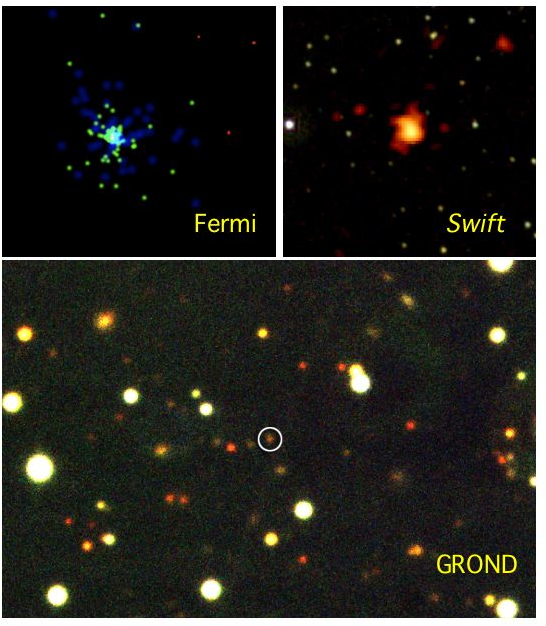
 Credit: Gamma-Ray: NASA/DOE/Fermi LAT Collaboration; X-ray/UVOT: NASA/Swift/Stefan Immler; Optical: MPE/GROND
Credit: Gamma-Ray: NASA/DOE/Fermi LAT Collaboration; X-ray/UVOT: NASA/Swift/Stefan Immler; Optical: MPE/GROND
The Extremest
Gamma-ray bursts come and go. That's what they're supposed to do. But as new windows on the Universe open up, new bursts that astonish and delight astronomers reveal themselves. The latest example is GRB 080916C, an explosion of a massive star which occurred 12 billion years before 7:13 p.m. EDT on Sept. 15, 2008, and which was detected by the Large Area Telescope and Gamma-Ray Burst Monitor instruments on the Fermi Gamma-Ray Space Telescope. The Fermi LAT observation of the burst is shown above left. The burst was also detected by the instruments on the Swift Telescope - an image of the burst at UV and X-ray wavelengths is shown above right. Followup observations by the Gamma-Ray Burst Optical/Near-Infrared Detector (GROND) on the 2.2m Max Planck Telescope at the European Southern Observatory, La Silla, Chile pinned down the distance to the burst. The GROND identification is shown in the bottom image above. At the distance determined by GROND, this Fermi burst had the greatest total energy, the fastest motions (more than 99.9999% the speed of light!) and the highest-energy initial emissions yet seen. The Fermi observations also suggest that the highest-energy emissions come from different parts of the jet or are created through a different mechanism, since there was a five second time lag between the highest energy emission and the emission at lower energies.
Published: February 23, 2009
<
HEA Dictionary ● Archive
● Search HEAPOW
● Other Languages
● HEAPOW on Facebook
● Download all Images
● Education ● HEAD
>
Each week the HEASARC
brings you new, exciting and beautiful images from X-ray and Gamma ray
astronomy. Check back each week and be sure to check out the HEAPOW archive!
Page Author: Dr. Michael F. Corcoran
Last modified Tuesday, 27-Feb-2024 10:15:17 EST


